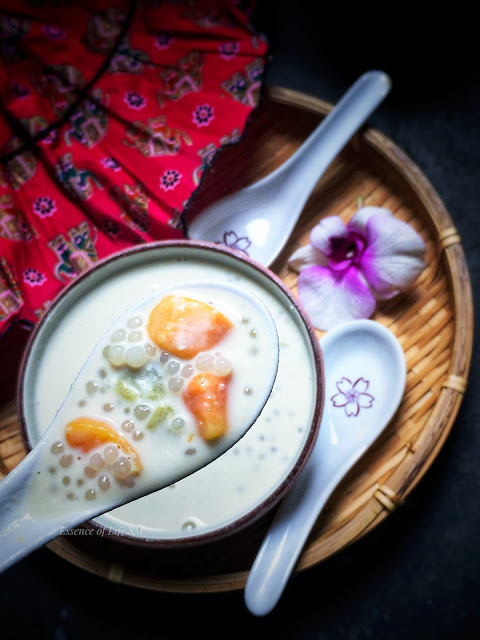BUBUR CHA CHA
 |
| BUBUR CHA CHA |
Bubur Cha Cha - Rather than the dessert I was intrigued by the name. Cha... Cha... Cha... it sounds like some kind of a dance . Similar to the Cha... Cha... Cha... dance, this coconut milk dessert is interestingly colourful with variety of ingredients, flavour and texture. This dish is actually pronounced “bo bo cha cha” or “mo mo cha cha“. In Malay, “bubur” means “porridge”, and “cha cha” means “well”. And sometimes its mis-interpretted for the Hokkien word “che che” which means “prosperity”.
Bubur Cha Cha’ is a coconut milk dessert which commonly contains sweet potatoes, taro & sago. Each region has a variation of Bubur Cha Cha: some include banana, black eyed peas, colourful tapioca jellies, or yam instead of sweet potato. This coconut milk dessert is traditionally eaten and served to friends and family during the 15th of the Chinese New Year. But it is now also commonly found all year round.
In Malaysia and Singapore, Bubur Cha Cha is usually served as a dessert or sometimes for supper. This is one of the most popular Nyonya/Peranakan desserts which is colourful & delicious. It is one popular dessert sold by the street vendors in Penang. Bubur Cha Cha is one of the local favourites along with Cendol, ABC(Air Batu Campur), Bandung etc., among locals.
Bubur Cha Cha is more or less like a porridge or a soup, it can be easily
masqueraded into a mild dessert. This dessert is a combination of different coloured sweet potatoes, taro & sago in Pandanus infused Coconut milk base , midly sweetened with Sugar or Rock Sugar. What I like the most about this traditional Malaysian dessert is its
colourful presentation. Needless to mention that its taste is
wonderfully good because it’s made with fragrant sweet coconut base flavoured with pandan leaves,
delicious sweet potatoes and tapioca pearls (sago pearls).
This kind of mild dessert is usually served at the end of a meal. They
are light, refreshing and all the more nutritious. This particular
Dessert/Soup is considered to be a dessert with cooling nature. This Dessert is great for
summer, perfect to rustle up for taking the edge off the scorching
heat. Bubur Cha Cha can be served Warm/Cold. But I personally
feel this Dessert Soup tastes delicious when served chilled. This sweetened coconut milk dessert is served throughout the day as a dessert, snack or even supper.
For SOUTHEAST ASIAN DESSERTS, Click here...
Cuisine - Nyonya/Peranakan, Southeast Asian
Course - Dessert
Difficulty - Easy
Serves - 2-3
Author - SM
Cooking Time - 30 - 45 Minutes
For more DESSERTS, Click here...
HOW TO MAKE NYONYA BUBUR CHA CHA
 |
| BUBUR CHA CHA |
INGREDIENTS:
To Steam Cook the Sweet Potatoes & Taro:
Orange coloured Sweet Potato - 1/4 CupPurple coloured Sweet Potato - 1/4 Cup
Yam/Taro - 1/4 Cup
To Cook Sago Pearls:
Sago Pearls - 3 TablespoonsWater - 11/2 Cups
Salt - 1/4 Teaspoon
For Bubur Cha Cha:
Rock Sugar - 1/2 Cup
Pandan Leaves - 2 Nos.
Thick Coconut Milk - 11/2 - 2 Cups
METHOD:
Cooking the Sweet Potatoes & Yam/Taro:
- Fill the Steamer/Pressure Cooker with 1-2 Cups of Water.
- Allow it to boil.
- Clean, Peel & Wash the Sweet Potatoes & Yam.
- Cut them into small cubes.
- Gently place the steaming tray with cubed Sweet Potatoes & Taro into the Steamer.
- Cover the lid of the Steamer and steam cook on a medium flame for about 20-30 minutes or until done.
- Remove the steaming tray from the steamer and allow it to cool down for about 5-10 minutes.
Cooking Sago Pearls:
- Boil 11/2 Cups of Water in a Saucepan.
- Once the water boils, add 3 Tablespoons of Sago Pearls and mix well.
- Bring it to boil again and reduce the flame to medium.
- Cook without cover for 5 Minutes, stirring occasionally.
- Switch off the flame, cover the saucepan, let Sago pearls soak for about 10-15 minutes.
- After soaking for 10 minutes, the Sago Pearls are partially cooked. (semi-translucent with a white spot in the centre).
- Drain and rinse the Sago Pearls with running water until it is cooled.
- If you are adding the Sago Pearls into hot Desserts, can use them right away.
- Rest of the cooking takes place while the Sago Pearls are added into hot desserts.
- If you are using the Sago Pearls in Cold Desserts, It should be fully cooked.
- If so, bring another 1 litre of Water to the boil, add in the Sago Pearls.
- Bring it to boil again and turn off the flame, cover and let it soak for about 8-10 minutes.
- After soaking the Sago Pearls would have turned fully translucent.
- Drain and rinse the fully cooked Sago Pearls with running water.
For Bubur Cha Cha:
- In a saucepan, pour in the Coconut Milk, knot the Pandan Leaves and add it into it.
- Add Rock Sugar along with 1/2 a cup of Water and cook on a low flame until Rock Sugar melts.
- Add partially cooked Sago Pearls and give a quick stir. cook this on a low flame for about 8-10 minutes.
- Now add steam cooked Sweet Poatatoes, Taro & give a quick stir.
- Cook this on a low flame until it reaches the desired consistency.
- Switch off the flame.
- Serve Bubur Cha Cha Warm/Chilled.
NOTES:
- Adjust the consistency of Bubur Cha Cha to suit your preference.
- Can also add Yam, Banana, Black-eyed Peas etc., to this Dessert.
- Use a variety of coloured Sweet Potaoes for vibrant Bubur Cha Cha.
- I have used Rock Sugar in the recipe which yields a mild note of sweetness.
- Can substitute it with preferred sweeteners.
- Cook Sago Pearls partially/fully depending on when you are adding it into the Dessert.










0 comments